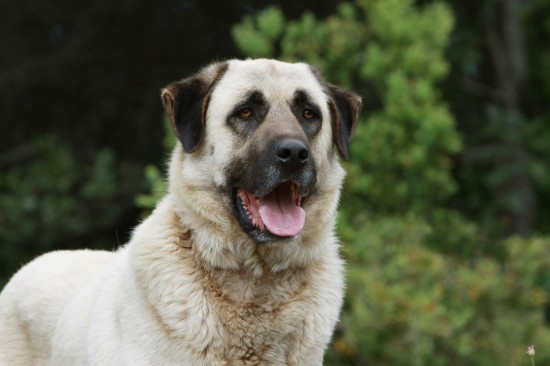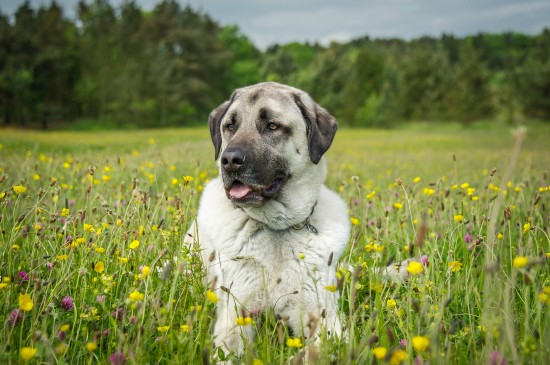


The Anatolian shepherd dog originated in Anatolia in central Turkey, but a large part of the modern development of the breed took place in North America. A large, strong herding and guarding breed, the Anatolian shepherd dog is much prized for its superior hearing and eyesight, as well as it’s quick turn of speed and strongly protective instincts, making it one of the most effective shepherd dogs in the world.
They are classed as large dogs, which stand between 26-31” tall at the withers, and can weigh up to 150lb, with males being larger than females.
The breed’s significant ability when it comes to guarding and livestock protection is partially the result of selective breeding, but also largely down to the natural traits that the dog itself possesses. They are independent, highly protective and very committed to their working role, and able to guard and manage flocks in remote areas without human assistance. They are used to travelling long distances as part of their working role, and are incredibly alert and wary when placed into a working guarding job. They are fearless with predators and considered to be excellent deterrents to large predators, as well as being more than capable of seeing off packs of animals like wolves, and even killing or seriously injuring an attacking wolf.
It is this distinct and high-level combination of traits that has ultimately provided a new and rather unique working role for the Anatolian shepherd dog in a country far from their native Turkey; supporting the Cheetah Outreach Project in South Africa!
If this sentence immediately gives you visions of a large, wary dog protecting a pride of wild cheetahs, however, think again… In this article, we will tell you more about this unusual and unique working dog role, and how it is helping with conservation efforts.
Read on to learn more!
The cheetah is the fastest land animal in the world, and also a fearsome predator that is not picky about where they find their potential meals! However, as a wild cat that is classed as endangered for conservation purposes, cheetah numbers are on the decline in their native South Africa, and this is a serious problem as the majority of the cheetahs remaining in the wild live outside of protected areas and reserves, and often range across land that is farmed and grazed.
As the cheetah is a high-level predator that poses a serious threat to livestock numbers and herds, cheetahs are as a result of this often killed by farmers in order to protect their livestock, inadvertently contributing to the cheetah population crisis.
Due to this, the Cheetah Outreach Project settled upon a unique way to assist farmers with protecting their livestock from hungry cheetahs, without the need to kill them on sight; using imported Anatolian shepherd dogs to guard their herds!
Despite the distance between their native Turkey and the ranges of South Africa, the climate of both regions is broadly similar. Summer brings extreme heat and very little rain, while the winters are harsh and very cold. The coat of the Anatolian shepherd is well designed to offer protection from weather of these types, offering insulation in the winter and protection from the hot sun during the summer months, and they are also able to thrive for several days at a time with little food or water. They also have a top running speed of up to 75kph, and while this is significantly slower than the cheetah at a flat-out run, at least gives the dog a fighting chance of keeping up!
Ergo, the Cheetah Outreach Project has imported significant numbers of the Anatolian shepherd dog to South Africa, to be used by farmers as herd guarding dogs. This means that when the herds are roaming remotely with no human supervision, the Anatolian shepherd is on guard and ever watchful, and will deter most potential predators such as the cheetah, and fight to protect their herds if put on the spot.
This in turn means that farmers can trust that their herds are in safe hands (or paws!) and greatly reduces the need to shoot cheetah on sight in order to protect their flocks.
In areas of South Africa such as Limpopo and the North West Provinces where the Anatolian shepherd dog is widely used, livestock losses have been reduced by up to 95-100%, proving that the Anatolian shepherd dog is more than up to the task!
The Anatolian shepherd dog takes their guarding role very seriously, and some of the dogs placed in the area by the Cheetah Outreach Project have faced significant dangers when protecting their herds, and still remained committed to their work!
One such dog, Crickey, was attacked by a leopard when he was just seven months old, and required veterinary treatment for some fairly serious wounds. While he was in recovery in the home of the farmer that owned him, he broke out of the house on his first night back from the vets, and walked 14km back to his herd to take care of them!
The role of the Anatolian shepherd dog in cheetah conservation has led to a great reduction in cheetah kills of livestock, and subsequent culling of cheetahs by affected farmers. Thanks to the work of the Anatolian shepherd dog and Cheetah Outreach, the endangered cheetah is able to survive within their home country and breed and maintain their lives within their natural, native environment.
Copyright © 2005-2016 Pet Information All Rights Reserved
Contact us: www162date@outlook.com